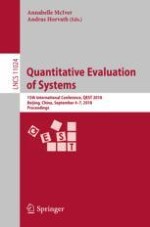2018 | Buch
Quantitative Evaluation of Systems
15th International Conference, QEST 2018, Beijing, China, September 4-7, 2018, Proceedings
herausgegeben von: Prof. Annabelle McIver, Andras Horvath
Verlag: Springer International Publishing
Buchreihe : Lecture Notes in Computer Science
